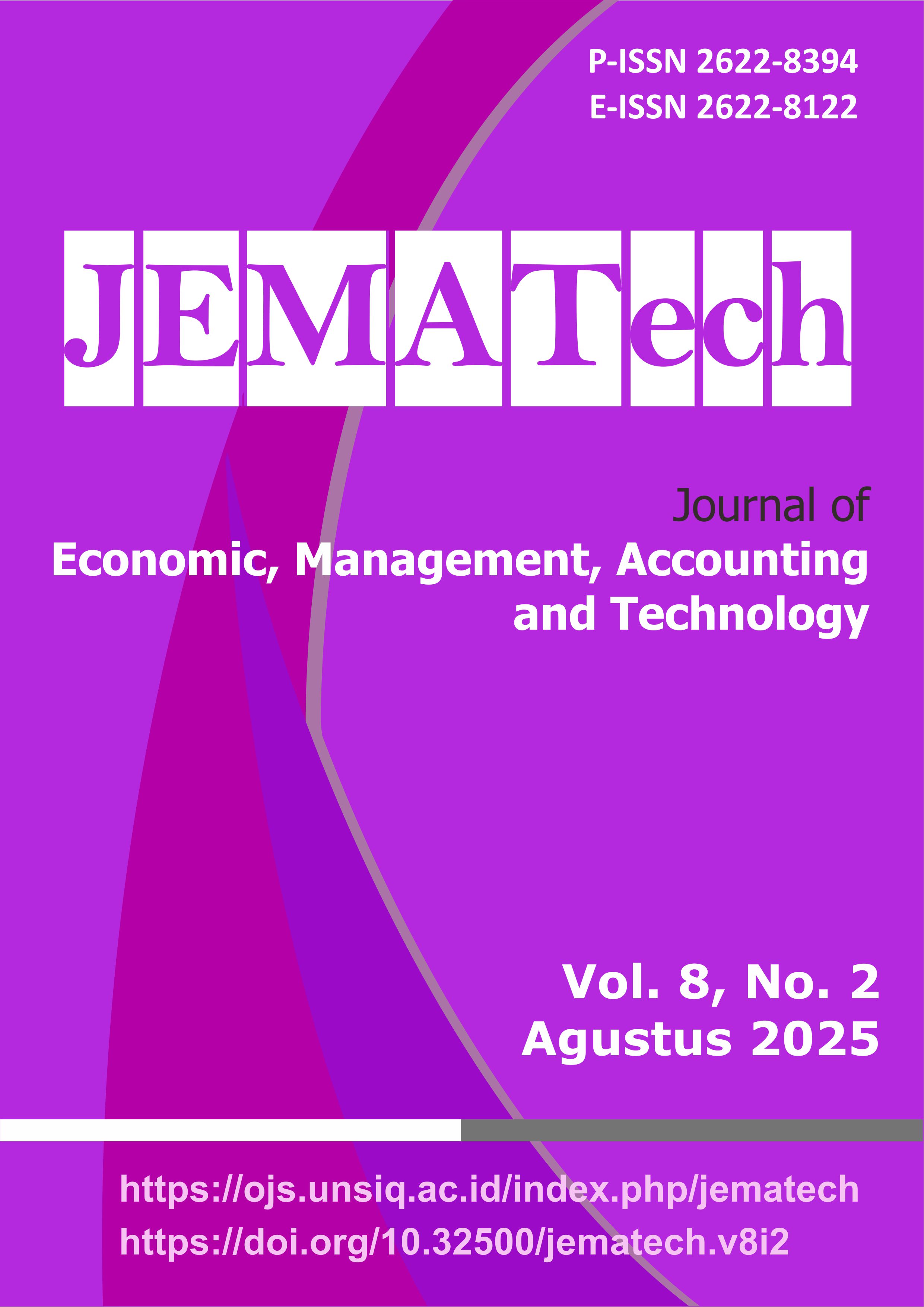Dynamic Capability, Knowledge Management, Organization Agility and Innovation on Competitive Performance of MSMEs in Batam City
DOI:
https://doi.org/10.32500/jematech.v8i2.8796Keywords:
organizational agility, knowledge management, innovation, dynamic capability, competitive performanceAbstract
This research This study aims to identify the factors influencing Competitive Performance in MSMEs, which has become increasingly crucial considering the significant challenges faced by MSMEs due to the impact of the COVID-19 pandemic, such as declining demand, difficulties in sourcing raw materials, and growing competition in the digital era. The population of this study consists of managers and business owners in Batam City, Indonesia, with a total of 260 respondents. The data analysis in this study employs quantitative analysis by distributing questionnaires to managers and business owners in Batam City, Indonesia, and conducting hypothesis testing.
The results of this study indicate that Dynamic Capability has a significant effect on Competitive Performance, Dynamic Capability has a significant effect on Organizational Agility, Innovation has a significant effect on Competitive Performance, and Knowledge Management has a significant effect on Competitive Performance. Furthermore, Knowledge Management has a significant effect on Dynamic Capability, Knowledge Management has a significant effect on Innovation, and finally, Organizational Agility has a significant effect on Competitive Performance.
References
Anggraini, P., Aditi, B., & Bisnis, F. E. (2022). THE ROLE OF COMPETITIVE ADVANTAGE IN MEDIATING MARKET ORIENTATION AND ENTREPRENEURSHIP ORIENTATION IN THE PERFORMANCE OF UKMDI DURING THE COVID-19 PANDEMIC. 398–410. https://kemenkopukm.go.id/data-umkm,
Aswalmi Gusmita, L. S. (2007). THE IMPACT OF STRATEGIC DECISION MAKING APPROACH TO THE PUBLIC SERVICE PERFORMANCE WITH THE ROLE OF ORGANIZATIONAL AGILITY : A RESEARCH FRAMEWORK. Applied Microbiology and Biotechnology, 85(1), 2071–2079.
Awwad, A. S., Ababneh, O. M. A., & Karasneh, M. (2022). The Mediating Impact of IT Capabilities on the Association between Dynamic Capabilities and Organizational Agility: The Case of the Jordanian IT Sector. Global Journal of Flexible Systems Management, 23(3), 315–330. https://doi.org/10.1007/s40171-022-00303-2
Cronje, J. C. (2020). Designing Questions for Research Design and Design Research in e‑Learning. Electronic Journal of E-Learning, 18(1), pp13-24.
Davidescu, A. A. M., Apostu, S. A., Paul, A., & Casuneanu, I. (2020). Work flexibility, job satisfaction, and job performance among romanian employees-Implications for sustainable human resource management. Sustainability (Switzerland), 12(15). https://doi.org/10.3390/su12156086
Dawn. (2020). Complete Guidelines for the Implementation of the New Normal that Companies Must Comply with. https://disperindag.jatimprov.go.id/post/detail?content=panduan-lengkap-penerapan-new-normal-yang-wajib-dipatuhi-perusahaan
Fryer, L. K., & Dinsmore, D. L. (2020). The Promise and Pitfalls of Self-report: Development, research design and analysis issues, and multiple methods. Frontline Learning Research, 8(3), 1–9.
Grieshaber, S. (2020). Equity and research design. In Doing early childhood research (pp. 177–191). Routledge.
Helfat, C. E., & Peteraf, M. A. (2003). The dynamic resource-based view: Capability lifecycles. Strategic Management Journal, 24(10 SPEC ISS.), 997–1010. https://doi.org/10.1002/smj.332
Kwanda, V. R., & Widodo, M. W. (2022). Pola Knowledge Management UMKM dalam Meningkatkan Pendapatan Masyarakat Desa Sumengko. Economic Education and Entrepreneurship Journal, 5(1), 149–156. https://doi.org/10.23960/e3j/v5i1.149-156
Limanseto, H. (2022). The development of MSMEs as a Critical Engine of the National Economy continues to receive government support. https://www.ekon.go.id/publikasi/detail/4593/perkembangan-umkm-sebagai-critical-engine-perekonomian-nasional-terus-mendapatkan-dukungan-pemerintah
Mikalef, P., Krogstie, J., Pappas, I. O., & Pavlou, P. (2020). Exploring the relationship between big data analytics capability and competitive performance: The mediating roles of dynamic and operational capabilities. Information and Management, 57(2), 103169. https://doi.org/10.1016/j.im.2019.05.004
Najmi, K., Kadir, A. R., & Kadir, M. I. A. (2018). Mediation effect of dynamic capability in the relationship between knowledge management and strategic leadership on organizational performance accountability. International Journal of Law and Management, 60(2), 517–529. https://doi.org/10.1108/IJLMA-01-2017-0004
Nel Arianty. (2016). COOPERATIVE LEARNING METHOD TYPE NUMBERED HEADS TOGETHER (NHT) STUDENTS IN EFFORTS TO INCREASE LIVELINESS AND MATERIALS MANAGEMENT MARKETING MASTERY IN ECONOMICS FACULTY MUHAMMADIYAH UNIVERSITY OF NORTH SUMATRA. Analytical Biochemistry, 11(1), 1–5. http://link.springer.com/10.1007/978-3-319-59379-1%0Ahttp://dx.doi.org/10.1016/B978-0-12-420070-8.00002-7%0Ahttp://dx.doi.org/10.1016/j.ab.2015.03.024%0Ahttps://doi.org/10.1080/07352689.2018.1441103%0Ahttp://www.chile.bmw-motorrad.cl/sync/showroom/lam/es/
Nuraeni, R., Mulyati, S., Putri, T. E., Rangkuti, Z. R., Pratomo, D., Ak, M., Ab, S., Soly, N., Wijaya, N., Operasi, S., Ukuran, D. A. N., Terhadap, P., Sihaloho, S., Pratomo, D., Nurhandono, F., Amrie, F., Fauzia, E., Sukarmanto, E., Partha, I. G. A., … Abyan, M. A. (2017). PENGARUH DYNAMIC CAPABILITIES TERHADAP FIRM PERFORMANCE PADA PT SICHA JAYA SENTOSA. Diponegoro Journal of Accounting, 2(1), 2–6. http://i-lib.ugm.ac.id/jurnal/download.php?dataId=2227%0A???%0Ahttps://ejournal.unisba.ac.id/index.php/kajian_akuntansi/article/view/3307%0Ahttp://publicacoes.cardiol.br/portal/ijcs/portugues/2018/v3103/pdf/3103009.pdf%0Ahttp://www.scielo.org.co/scielo.ph
Nurjanah, L., Siagian, Y. M., Yusran, H. L., & Ariyanto, H. H. (n.d.). Asian Journal of Management Entrepreneurship and Social Science The Analysis Of Dynamic Capabilities And Sustainable Competitiveness On Sustainable Performance In Indonesia Private Higher Education. Ajmesc, 03(03), 2023. https://ajmesc.com/index.php/ajmesc
Pundziene, A., Nikou, S., & Bouwman, H. (2021). The nexus between dynamic capabilities and competitive firm performance: the mediating role of open innovation. European Journal of Innovation Management, 25(6), 152–177. https://doi.org/10.1108/EJIM-09-2020-0356
Purwianti, L. (2023). The role of innovation and absorption capacity mediation in improving hotel performance during the Covid 19 pandemic. Equity (Journal of Economics and Finance), 7(2), 171–192. https://doi.org/10.24034/j25485024.y2023.v7.i2.5251
Sakitri, G. (2021). Organizational Agility and Essential Talents. Management Forum, 35(1), 1–11. https://journal.prasetiyamulya.ac.id/journal/index.php/FM/article/view/510
Schilke, O., Hu, S., & Helfat, C. E. (2018). Quo vadis, dynamic capabilities? A content-analytic review of the current state of knowledge and recommendations for future research. Academy of Management Annals, 12(1), 390–439. https://doi.org/10.5465/annals.2016.0014
Schulze, J. H., & Pinkow, F. (2020). Leadership for organisational adaptability: How enabling leaders create adaptive space. Administrative Sciences, 10(3). https://doi.org/10.3390/admsci10030037
Setiadi, F., Tanudjaja, W. V., & Syamil, A. (2022). Peningkatan Organizational Agility Telkom Group Melalui Enterprise Resource Planning (ERP). Jurnal Ilmiah Mandala Education, 8(1), 702–722. https://doi.org/10.58258/jime.v8i1.2774
Sugito, P., & Kamaluddin, K. (2018). Innovation and Competitive Advantage: Knowledge Management, Talent Development and Social Capital Studies. Equity (Journal of Economics and Finance), 18(1), 100–117. https://doi.org/10.24034/j25485024.y2014.v18.i1.108
Suyono Saputra, Daihani, D. U., & Wahyudi, A. S. (2019). The Role of Strategic Planning and Innovation in Achieving Performance of Public Organization in Indonesia. International Journal of Economics and Management Studies, 6(10), 98–102. https://doi.org/10.14445/23939125/ijems-v6i10p113
Venthioa, J. O., & Dauda, I. Am. (2022). The Role of Knowledge Management, Knowledge Sharing, and Work Innovation on Employee Performance. Proceedings of the National Business Seminar, 217–229.
Wijaya, M., Hesnaiti, H., Robin, R., & Nainggolan, F. (2022). COVID-19 Outbreak Impact on Stock Return in Indonesia and Malaysia. Jurnal Keuangan Dan Perbankan, 26(2), 436–447. https://doi.org/10.26905/jkdp.v26i2.7618


